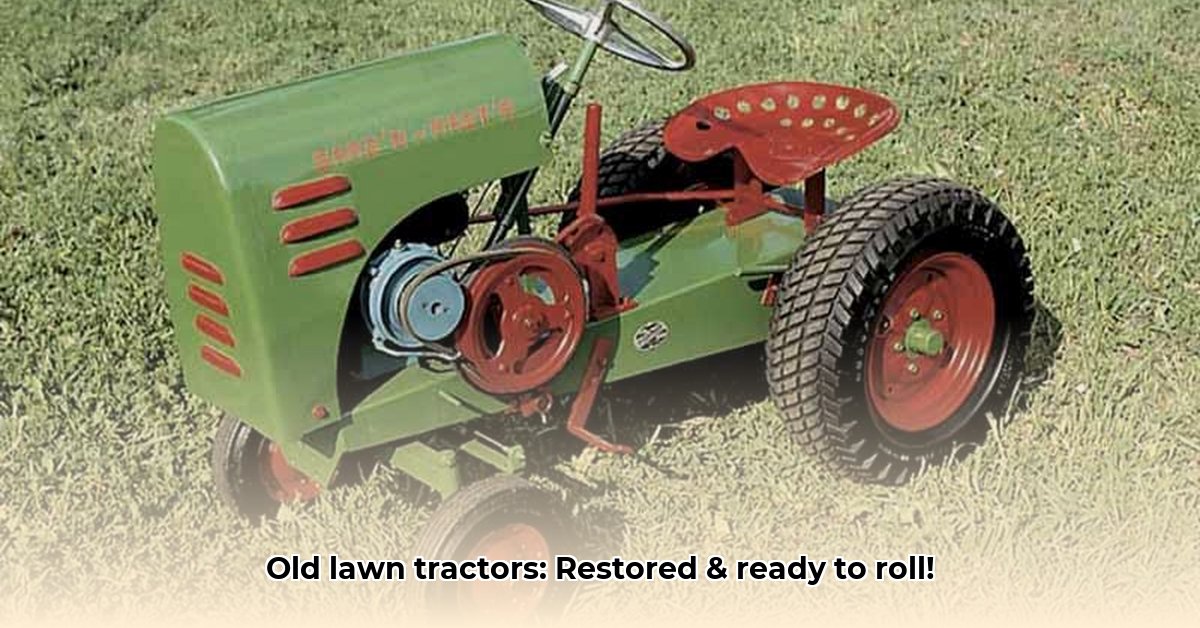
Old Lawn Tractors: A Buyer's and Seller's Guide
The satisfying rumble of a vintage lawn tractor, the scent of freshly cut grass—these evoke nostalgia and a simpler time. But beyond the sentimental value, there's a thriving market for these classic machines, attracting both seasoned collectors and newcomers eager to embrace a unique hobby. This guide navigates the exciting world of buying, selling, and restoring these nostalgic beauties, whether you seek a show-stopping restoration or a rewarding project tractor. For more information on older tractors, check out this helpful resource: International Harvester Tractors.
The Alluring Market for Vintage Garden Tractors
The market for classic lawn tractors is booming! Restored machines, especially those with iconic names like Sears, Simplicity, or even less-common brands, can command impressive prices. A pristine 1939 Sears Handiman, for example, might fetch $7,000. Yet, this doesn't exclude those on a budget. "Project tractors" – machines needing TLC – offer a more affordable entry point, from a few hundred dollars for a basic model to around $800 for something like a Bantam 3000. Finding the right tractor depends on your budget and mechanical skills. Are you a seasoned restorer or a curious beginner? This will significantly shape your search.
Assessing Condition: Restored Tractor vs. Project
Buying a fully restored classic is like buying a show-ready classic car; a project tractor is more like a charming fixer-upper house – a challenge, yet potentially more rewarding. A thorough inspection is paramount. Look for rust, worn components, and signs of previous repairs. Extra accessories (plows, cultivators) significantly boost value, as does the condition of the tires which can greatly influence price. The engine is vital: is it original? Does it run smoothly or cough like a chain smoker? These details are crucial in determining worth.
Pricing Your Old Lawn Tractor: Striking a Balance
Pricing correctly is crucial, whether buying or selling. Sellers should research comparable models on sites like eBay. Consider condition, attachments, and model desirability. Successful pricing balances market value with attracting buyers. Buyers, remember negotiation is key! Knowing the typical market price transforms you from a naive buyer into a savvy negotiator. How much are you willing to invest in your dream machine?
Buying Your Dream Machine: A Step-by-Step Guide
- Research: Explore reputable sellers and online forums for valuable advice and insights.
- Inspection: Examine the tractor meticulously; pay close attention to the engine – a problem here will cost you more to repair.
- Negotiate: Don't hesitate to negotiate, especially if you discover flaws during inspection.
Selling Your Old Lawn Tractor: Maximizing Your Return
- Presentation: Clean the tractor thoroughly and take clear, high-quality photos.
- Marketing: Advertise on online marketplaces and relevant forums; target your audience effectively.
- Pricing: Set a competitive price based on research; overpricing can deter buyers.
Restoring Your Old Lawn Tractor: A Rewarding Challenge
Restoring a vintage lawn tractor provides immense satisfaction. However, it requires patience and mechanical skills. Sourcing parts might involve online forums, specialized suppliers, or even salvage yards. Always prioritize safety—wear appropriate protective gear.
The Community: Support and Shared Passion
Connecting with enthusiasts is rewarding. Online forums and local clubs offer invaluable knowledge, assistance, and camaraderie. This brings a sense of community that is essential to the hobby, both for inspiration and for practical advice.
Invest in Time and Memories
Old lawn tractors represent history and superb craftsmanship. They offer a unique blend of restoration, history, and the satisfaction of bringing a piece of the past back to life. Each tractor has a story—discover yours!
How to Accurately Assess the Value of a Vintage Garden Tractor
Key Takeaways:
- The value depends on make, model, condition, and rarity.
- Restored tractors command higher prices than projects.
- Market demand and parts availability significantly influence value.
- Research and careful inspection are crucial for valuation.
Understanding the Market
Before falling in love, accurately assess the value. The market ranges from pristine restorations to rusty projects. A restored Sears Craftsman could fetch $7,000, while a project might cost a few hundred. The difference: condition and completeness.
Assessing Condition: The Key to Value
- Mechanical Integrity: Engine functionality is paramount.
- Cosmetics: Paint, dents, and rust affect value, but less than major mechanical issues.
- Completeness: Missing parts significantly devalue a tractor.
- Documentation: Service records and manuals add value.
Restored vs. Project Tractors: A Price Comparison
| Tractor Type | Typical Price Range | Considerations |
|---|---|---|
| Fully Restored | $1,000 - $10,000+ | Excellent condition; often show-quality. |
| Partially Restored | $500 - $5,000 | Some work needed; condition varies widely. |
| Project Tractor | $100 - $2,000 | Requires significant restoration. |
Finding Fair Market Value: Research is Your Friend
Research comparable models online and at local tractor shows. Consider location's impact on value.
Negotiating Price: The Art of the Deal
Negotiate intelligently, knowing your limits. Don't be afraid to walk away from an unreasonable price.
Selling Your Vintage Tractor Smartly
Use clear, detailed photos and descriptions. Price competitively and utilize online forums and social media.